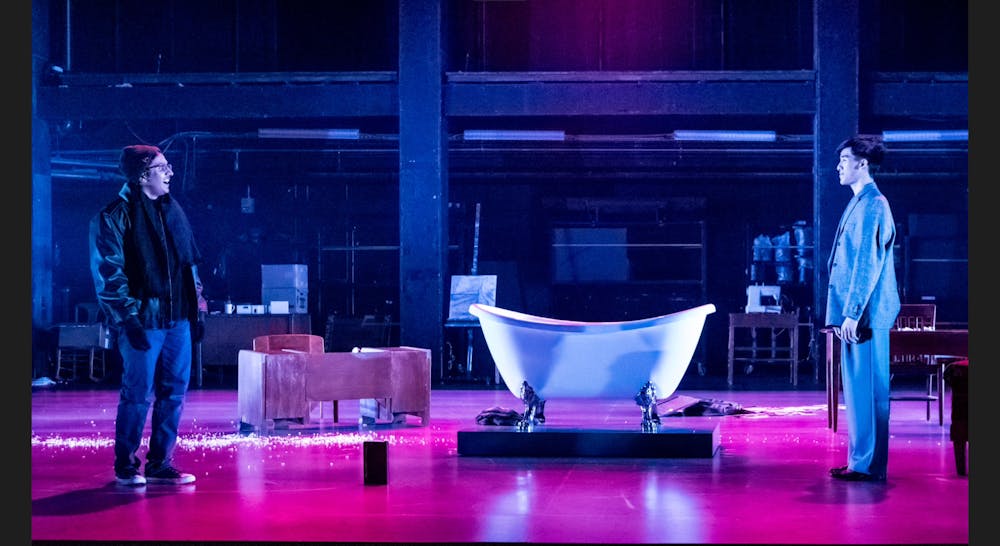A collection of boxes. A pair of sparkling red heels. “Flight of a Legless Bird,” written and directed by Ethan Luk ’24 with the help of retired Princeton English professor R.N. Sandberg ’70, opens where it ends. On one side of the stage, a group crowds around a collection of personal belongings of one of the play’s main characters, the late Hong Kong celebrity Leslie Chueng, cataloging them for display. Gloved and nearly clinical, they draw a sharp contrast to the opposite side where Robin, the play’s other central character, sits on the floor, sifting through a chaotic collection of unspecified items.
After this brief prologue, the play takes the audience back several decades and begins anew. Now, we meet Robin and Leslie in earnest. Robin, an eccentric, energetic, and passionate filmmaker, lives in New York City’s West Village during the AIDS crisis. Leslie, a rising star in the entertainment industry, acts and sings in Hong Kong. Their lives are separated by 8,000 miles but share a deep complexity.
Robin is estranged from his family living in Colorado — particularly his mother, who cares for him but doesn’t understand his life in New York City — and coping with a recent HIV diagnosis. Leslie’s relationship with his father is equally strained. Despite their love, neither parent can offer the kind of true community and support their child desires. Lack of community isn’t the only quality the men share, though: Leslie and Robin both feel trapped by something in their lives. For Leslie, it is his inability to love bravely in the way he desires, fearing he may be jailed for loving a man in Hong Kong. For Robin, he feels his HIV diagnosis causes him to push his loved ones away in spite of his desperate longing for community. This struggle for connection and freedom takes center stage as the characters strive to create identity and art in their lives.
This journey is represented both on the physical stage and through the characters’ geography. In the beginning, the two worlds that “Flight of a Legless Bird” operates within are tightly “partitioned,” Luk said in an interview with The Daily Princetonian. Literally, in the sense that Hong Kong and New York are on separate sides of the world, but also visually, by the physical separation of scenes on stage and the use of several large walls and set pieces. Over time, however, after an unlikely meeting in Varanasi, India, on separate trips around the world, the separation diminishes until “the delineations between Hong Kong and New York begin to blur” and “coalesce.” Luk also described how this arc within the play represents people who initially inhabit “isolated islands in this archipelago,” but eventually “find each other in the water of it all.”
Leslie and Robin ultimately find sources of connection in unexpected, melancholic ways. Both reconcile at some level with their parents. Leslie does so in a fantastical conversation with the ghost of his father, who expresses his love for his son and simultaneous anguish at his loneliness. Robin’s mother asks to take care of him, and eventually implies that she wants to visit him in New York City and see his art. Both Leslie and Robin are recognized for their artistic accomplishments. Leslie forges an almost familial bond with his colleague and close friend Anita, and eventually forms an openly romantic relationship with a man named Daffy, though he continues to wrestle with clinical depression. Robin creates audio recordings of love letters written to his close friend who is going blind due to HIV, a painful act of both compassion and mourning. Every joy is qualified by loss, yet the play allows its characters some uplifting moments.
“Flight of a Legless Bird” ends where it began, but reorients the opening scene with a slightly different framing. Contrary to the opening scene’s division between Leslie and Robin’s stories, in the play’s closing moments, the walls retreat and the stripped-down stage reveals Luk’s metaphorical sea between isolated islands. The lines blur between New York and Hong Kong, life and death, joy and mourning. Imbued with meaning and now connection, it is here — quietly, imperfectly — that hope emerges.
Emma Cinocca is a staff writer for The Prospect from Tulsa, Okla. She is a member of the Class of 2027 and can be reached at emmacinocca@princeton.edu.








